Holidays are a great opportunity to show love and appreciation to our most important people. We get together for dinner, decorate our houses, and give presents to each other. No wonder holiday seasons are so enticing and profitable for many businesses. We need to buy so many things!
Whether a customer wants to purchase a yearly subscription to a tool for their hard-working relative or prepare a perfect meal, you need to be there. You need to be the first one to offer your products. And how can you do it? With the help of holiday email marketing, of course!
Email marketing has always been a promotional strategy with the highest return on investment (ROI). It lets you connect with prospects personally, offer a relevant product selection just to this client, or restore an abandoned cart.
In this article, we’ll talk about how to leverage emails to boost your holiday sales. So, whether you’re preparing for a Valentine’s Day or planning your content strategy for the upcoming year, we’ll cover all the bases. You’ll learn what tools to use, how to personalize send-outs, and how to stay on top of the holiday email game.
We’ll also illustrate the information with holiday email marketing examples. Ready to turn each holiday newsletter into a campaign that resonates with the target audience and converts? Let’s start.
The Power of Holiday Email Marketing
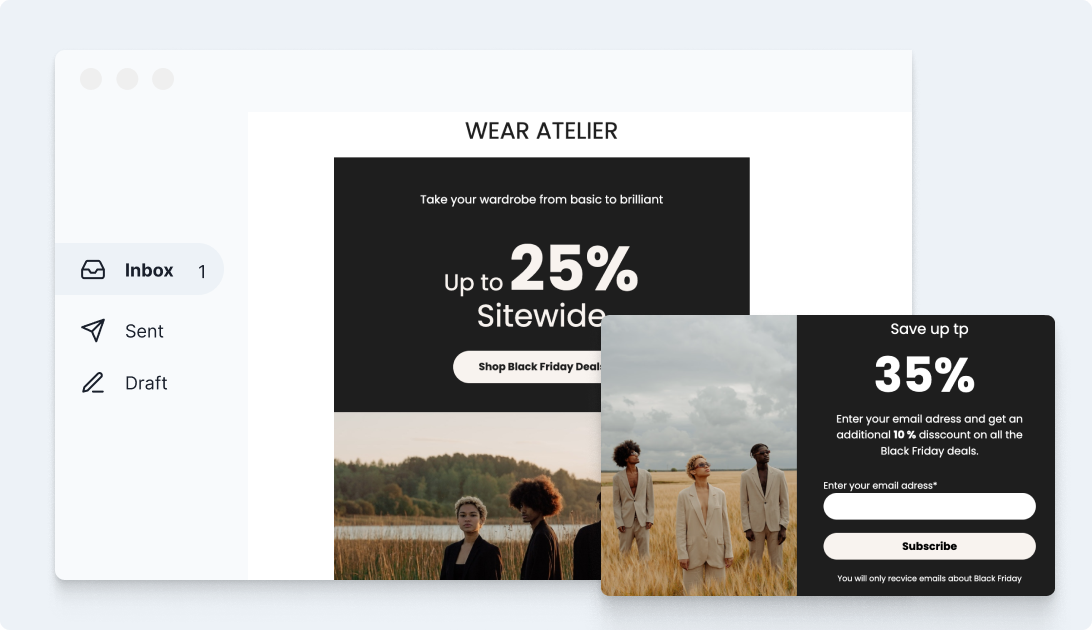
What can be better than email marketing? Holiday email marketing. With email marketing being critical for 87% of brands, according to Litmus, the holiday season provides even more opportunities for companies to sell.
Let’s be honest; we all become more prone to buying amid a seasonal wave of enthusiasm. So, your online store can earn new clients, re-engage existing ones, and even say “Hello” to cold leads.
Why Holiday Email Marketing Is Crucial
Imagine this: With the holidays quickly approaching, your clients are excited to find the best offers and one-of-a-kind treasures. This is where direct audience communication, such as holiday email marketing, comes into play. Greeting them with discounts and messages that are in line with the holiday mood is your digital version of a handshake.
But with so many other methods available, why concentrate on email? The key to its success is its effectiveness. Compared to other marketing formats like social media, direct mail, and sponsored search, email marketing has a median return on investment (ROI) of 122%, which is more than four times greater. It works even better during the holidays when people are actively looking for ideas and offers.
Of course, you also need to optimize your website to handle an increasing amount of traffic. Plus, it’s wise to conduct on-site conversion rate optimization to ensure maximum output from your holiday email marketing campaigns.
Benefits Across Different Holidays
1. Sales Boost
Whether it’s Black Friday or Cyber Monday, email marketing can account for about 20% of online sales. How? You can tailor messages to every consumer segment to appeal to their preferences and impact their buying decisions. An email with compelling offers and discounts sent at just the right time is a great sales driver.
That’s where you should be proficient at segmenting your audience. By connecting email marketing software with the eCommerce content management system, you can have a unified database containing previous purchasing behavior. It can serve to craft targeted holiday promotions that boost conversions, increase loyalty, and enhance the shopping experience.

2. Engagement
Engagement is more than just replying to emails; it’s about building relationships. Your consumers will find value in receiving holiday emails with specialized content, including gift ideas or seasonal advice. It promotes interaction and establishes your brand as attentive and helpful.
Suppose you sell home decor. Your holiday email may include a guide on “Decorating Your Home for the Holiday Season”. It should mention your products, of course. This way, you incorporate promotion into engaging and helpful content.
3. Brand Loyalty
Holiday marketing emails also provide a chance to boost loyalty. It’s a great time to show your appreciation and thank customers for staying with you. That’s where you should think not like a seller but rather as a partner or a friend, expressing how you value the relationship with a particular person.
What can a well-crafted, thoughtful message be like? If you have a loyalty program, consider sending an email with exclusive early access to your holiday sale. It shows the client’s exclusivity and encourages them to purchase before the rest of the consumers.
Calendar of Holidays: A Strategic Overview
Each holiday has its own spirit. They also require a different approach to your holiday email marketing strategy. Let’s list the most critical holidays in the yearly calendar and what you should consider when tailoring your campaigns:
- New Year’s Day (January 1st): It’s a time when we start a new life, make resolutions, and expect something to change for the better. Use it to deliver motivational messages and launch new products.
- Valentine’s Day (February 14th): Gift-giving opportunities and love are in the air. Ideal for advertising potential presents.
- Easter (Variable dates in March/April): A holiday typically celebrated with family, often associated with spring and renewal.
- Mother’s Day (Second Sunday in May): This day is all about giving and receiving kind messages as we celebrate mothers everywhere.
- Father’s Day (Third Sunday in June): Similar to Mother’s Day, but with a focus on dads.
- Independence Day (July 4th in the U.S.): A barbecue and fireworks-filled patriotic celebration. Ideal for summer-related promotions.
- Halloween (October 31st): It’s a fun and spooky season, providing opportunities for themed and creative marketing.
- Black Friday (The day after Thanksgiving in the U.S.): The day when the Christmas shopping season unfolds, marked with big sales and gift preparations.
- Cyber Monday (Following Monday after Thanksgiving in the U.S.): The online version of Black Friday, which mainly focuses on eCommerce sales.
- Christmas (December 25th): The big one. It’s a time for giving, receiving, and, of course, shopping.
How Your Email Strategy Should Reflect Each Holiday
How does your strategy change with each season? Let’s touch upon this topic to see how to match your email campaigns with each holiday’s flavor.
Tailoring to the Holiday Spirit
- New Year’s emails: January 1st is the first day of a new life, a symbolic transition day. Emphasize new beginnings and fresh opportunities. Inspire your audience and encourage them to begin the year on a positive note, showing how they can incorporate your brand’s offerings into this setting.
- Valentine’s Day emails: Celebrate relationships. Each one counts not only romantic ones. This day can be great for appreciating friendships and familial bonds. Even more, why not suggest buyers to show love for themselves? Unique gift ideas, special deals, and tips on expressing love are all valuable content for send-outs.
- Easter emails: Tap into the topic of renewal and family togetherness. Use images filled with warmth, hope, and cuteness, such as blooming flowers and pastel colors. Consider family-friendly promotions or content.
- Mother’s and Father’s Day messages: Concentrate on gratitude and sincere emotions. Include meaningful gift selections to thank parents for being there and share stories or testimonials that honor parenthood.
- Independence Day campaigns: Flags and patriotism are everywhere, so your themes should also resonate with the general mood. It’s also the middle of the summer, so apart from patriotic imagery and colors, summer-themed products or promotions can also convert prospects into customers.
- Halloween communications: Get a little naughty, playful, and inventive. Humorous texts and mysterious graphics establish a light-hearted connection with recipients.
- Black Friday and Cyber Monday emails: That’s where speed matters, so most online retailers leverage a sense of urgency, countdowns, and timers to spur interest around the deals. Bundle products, offer discounts, and prepare your website for the traffic that awaits.
- Christmas campaigns: Set a warm, festive tone. It’s all about gift-giving, so present guides and special holiday deals can do wonders for your sales.
Timing Is Key
People express interest in a particular event in advance, browsing products and searching for more information. For this reason, you should determine the best time to launch email campaigns early. At the same time, Black Friday and Cyber Monday sales are typically made on the spur of the moment. So, think of limited-time offers.
Preparing Your Email Marketing Toolbox
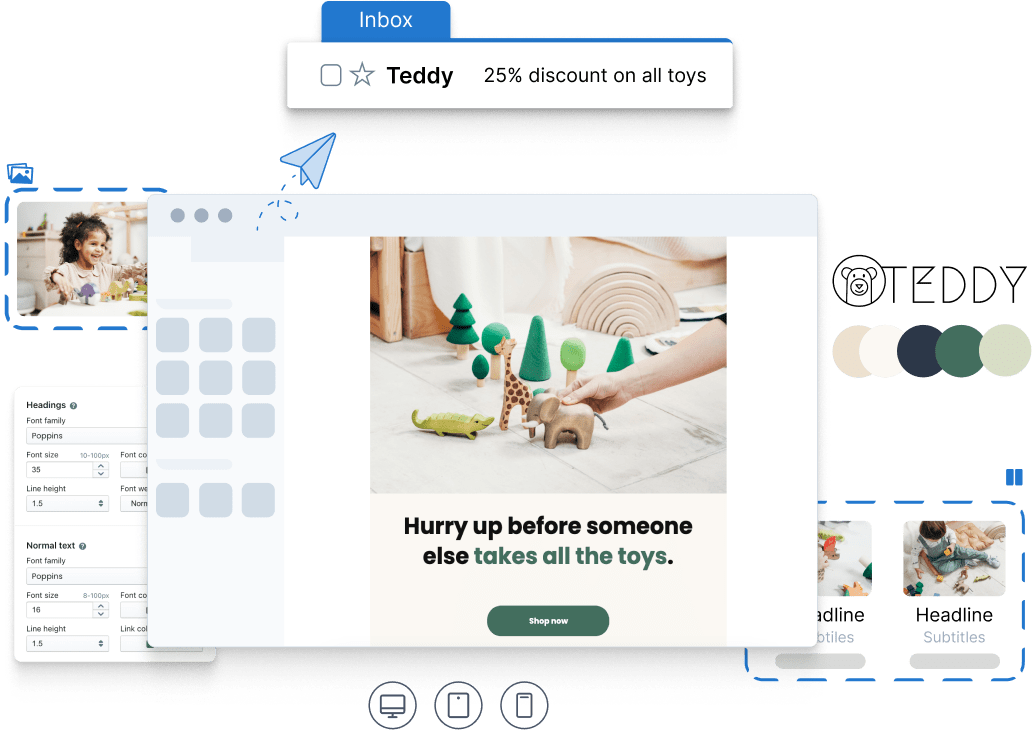
Winning your email marketing game is all about the right tools. You know what holidays to mark in your calendar. Now, it’s time to start building campaigns that resonate. Successful email marketing has three pillars: strategic planning, targeting, and analysis. Let’s bring up some strategies that can ensure it.
The first is segmentation. It’s the initial step when personalizing emails. Shoppers may have different intentions, from hunting for bargains to making purchases at the last minute. Your task is to cater to each category so that the received emails seem made just for them.
Here are three main types of segmentation:
- Behavioral (based on past purchase history or email engagement);
- Demographic (focuses on a client’s age, location, gender, etc.);
- Psychographic (includes lifestyle and interests).
Depending on the chosen factor, you can tweak the content. For example, someone buying kids’ toys may want to get something like this on Easter, while singles/couples distinction may serve for creating Valentine’s promotions.
As for tools, the primary goal of using them is automation. They reduce manual work and let you group recipients to send bulk messages with several clicks. Whether you need personalized emails or an automated series triggered by particular actions, Get a Newsletter can help you out with these functions.
Take care of the email appearance. You can find lots of good-looking design templates for your email newsletters at Get a Newsletter as well, which offers a great and user-friendly tool for building emails. Remember that the letter should look good on desktop and mobile devices, so go for responsive design.
At last, prepare for the holiday season by cleaning your subscriber list. It’s better to have fewer recipients but ensure these are active and existing accounts rather than sending emails to everyone on your list, even if they have been inactive for years.
To grow your email list, create lead magnets, i.e., useful materials in exchange for subscribing to newsletters. It can be a holiday gift guide or an exclusive webinar. Offer incentives, like a special discount.
Crafting Holiday-Specific Campaigns
Now, it’s time to create the first campaign using the tools and information mentioned above. Start with catchy holiday email subject lines. It may be the only chance to attract the reader’s attention if they decide not to open the email. So make them irresistible:
- Be clear and holiday-specific: A Valentine’s Day email subject could be “Love is in the Air! Exclusive Deals Just for You”.
- Create urgency: For Black Friday, a subject line like “24-Hour Flash Sale: Grab Your Deals Before They’re Gone!” can be very effective.
- Invoke emotion: For Christmas, try something heartfelt like “Spread the Joy with Our Special Christmas Collection”.

Then, proceed to the email design and marry it with the holiday’s theme. Christmas traditional colors are red and green. Bold and attention-grabbing ones are suitable for Black Friday, and soft, romantic ones should appear in Valentine’s Day templates.
The same rules apply to images and animations. A recipient should grasp the message immediately, whether the copy contains falling snow, cupids, or elegant floral designs.
Employ gamification with interactive elements. For example, consider adding user-engagement components like a clickable Easter egg hunt for holidays like Easter. Adding social proof is another universal piece of advice for boosting clicks. During Mother’s or Father’s Day, include testimonials or stories from other customers sharing how they celebrated the occasion with your products.
Personalization Across Holidays
Once you’ve segmented the audience, you can send tailored campaigns. The easiest way to personalize an email is to address the recipient by name. But there’s more to it. A person should feel that you take into account their interests, behaviors, and preferences.
Here is how the Priceline travel agency prepared its newsletter with a personalized year recap.
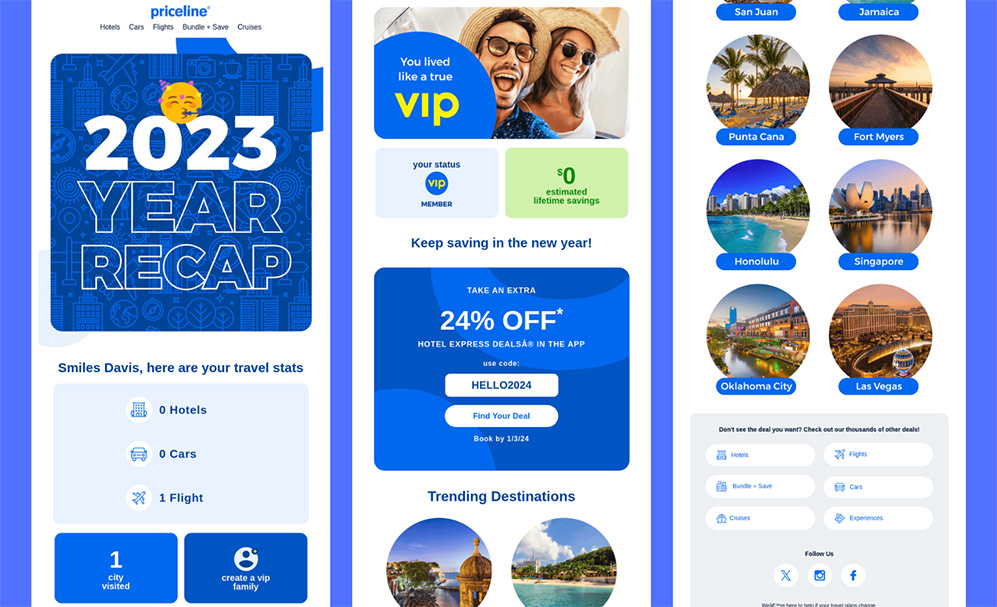
Use behavioral triggers to send emails. Suppose a person abandons the cart during a Black Friday sale. Remind them about the incomplete order with a personalized message or an additional discount.
You can also personalize emails based on the recipient’s location. For example, “Merry Christmas from sunny California!” or “Season’s Greetings from snowy New York!” You may even go one step further and congratulate them on region-specific holidays like Diwali in India. Language localization is among the ways to add a more personal touch.
How can you ensure your holiday marketing emails are not just opened but remembered? Consider the following unique elements:
- Storytelling, such as crafting a narrative about finding the perfect Christmas gift;
- Scavenger hunts with clues, holiday-themed puzzles, interactive gift finders;
- Personalized video messages, filmed with tools like Vidyard, where you can address every customer personally, such as “Happy Holidays, [Name]! Here’s a special message just for you!”
Testing and Optimizing Your Holiday Marketing Emails
The email is ready for sending. But what will it look like when a person gets it? To answer this question, you need to test the electronic letter.
Check how it performs across all devices using solutions in your email marketing software, like a preview mode, or by sending a test email to yourself. Click every link, button, and interactive element to avoid sending copies with broken links or non-functioning elements. Optimize the email by removing heavy components if it takes too long to load.
Do you have several ideas for organizing the email but don’t know which one to choose? There is a solution. Employ A/B testing or split testing. It’s when you compare how two versions of an email perform in real life and which triggers a greater response. You can test various email components:
- Holiday email subject lines to see which yields a higher open rate;
- Content (call-to-action placement, different types of images or layouts);
- Timing (sending emails at different times or days to determine those with the highest engagement).
Suppose you think that your subject line for a Black Friday campaign is too promotional and may seem aggressive. Test how your audience reacts to a more direct version. Timing tests, in turn, are crucial for time-sensitive holidays like New Year’s Eve.
So, the holiday email campaign is in full swing. After the dust settles, it’s time to measure results. That’s where you need to analyze key metrics, such as:
- open rates;
- click-through rates;
- conversion rates;
- unsubscribe rates.
Email platforms, like Get a Newsletter usually provide in-built analytics to track these indicators. Ask for feedback, sending surveys or feedback forms. Compare the performance of different holiday campaigns. It’s possible that strategies that were successful for Easter weren’t as successful for Halloween.
Advanced Strategies for Specific Holidays
Now that we’ve examined popular holidays like Valentine’s Day and Christmas, let’s focus on a few advanced holiday email marketing tips. These strategies cover lesser-known holidays and creative techniques for holiday email marketing to distinguish your ads from the competition.
These holidays may not be as significant as those brought up above, but they also deserve your attention:
- Small Business Saturday (Day after Black Friday): It’s the best time to talk about the importance of supporting local or small businesses.

- International Women’s Day (March 8th): Send out emails on this day that highlight the accomplishments of women or provide exclusive deals on items targeted towards women.
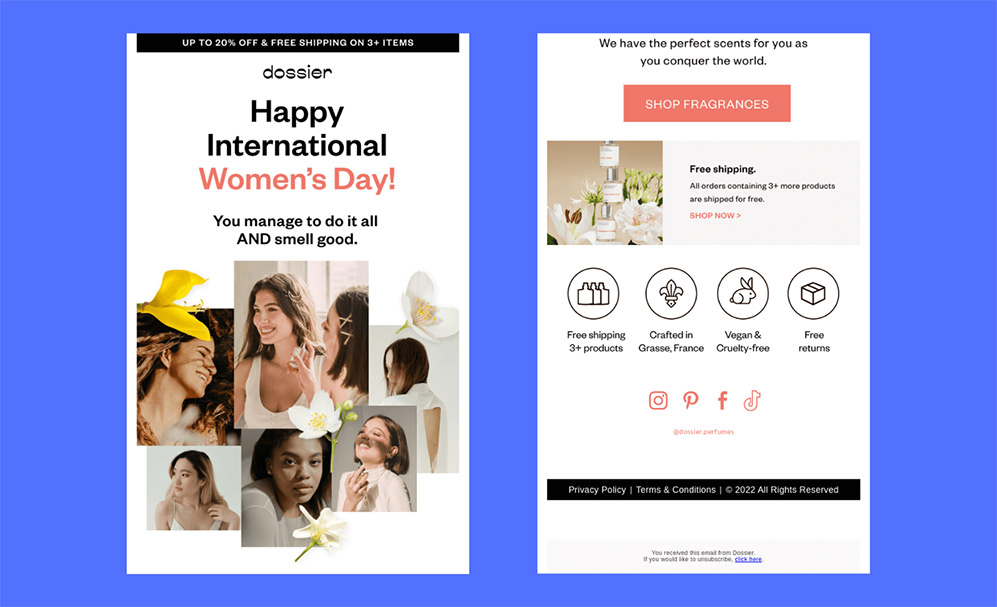
- Earth Day (April 22nd): Do you sell eco-friendly products or promote such values? Use this holiday to share your sustainability practices or promote eco-friendly products.
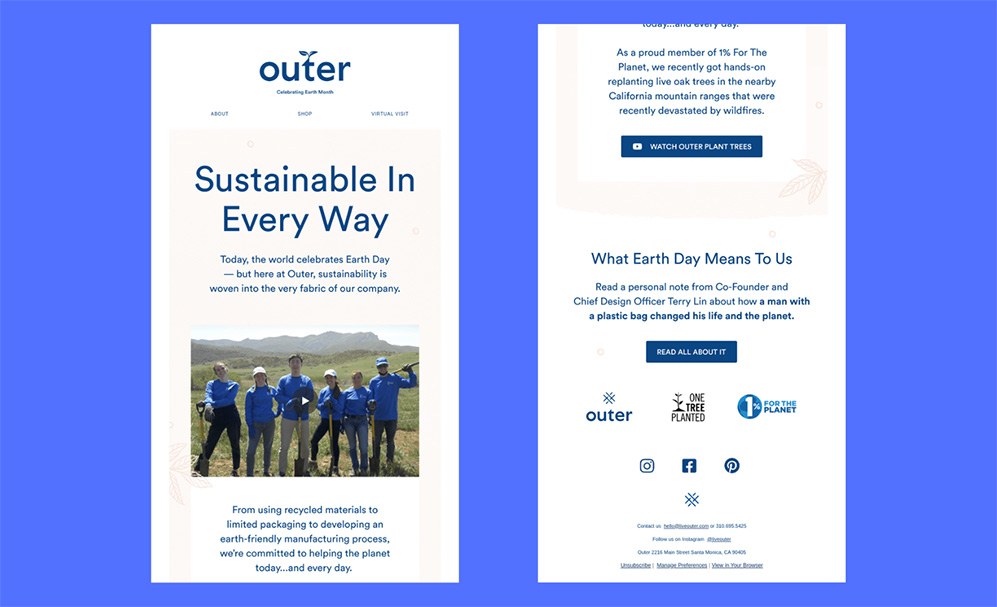
- Back to School (Late August/Early September): Parents and students will appreciate your emails promoting school supplies, clothing, or courses.

- Giving Tuesday (Tuesday after Thanksgiving): This day aims to promote the idea of giving back, such as supporting nonprofit organizations. Link your company’s name to a worthy cause and invite consumers to donate. Emails can highlight the impact that their purchases or involvement will have.
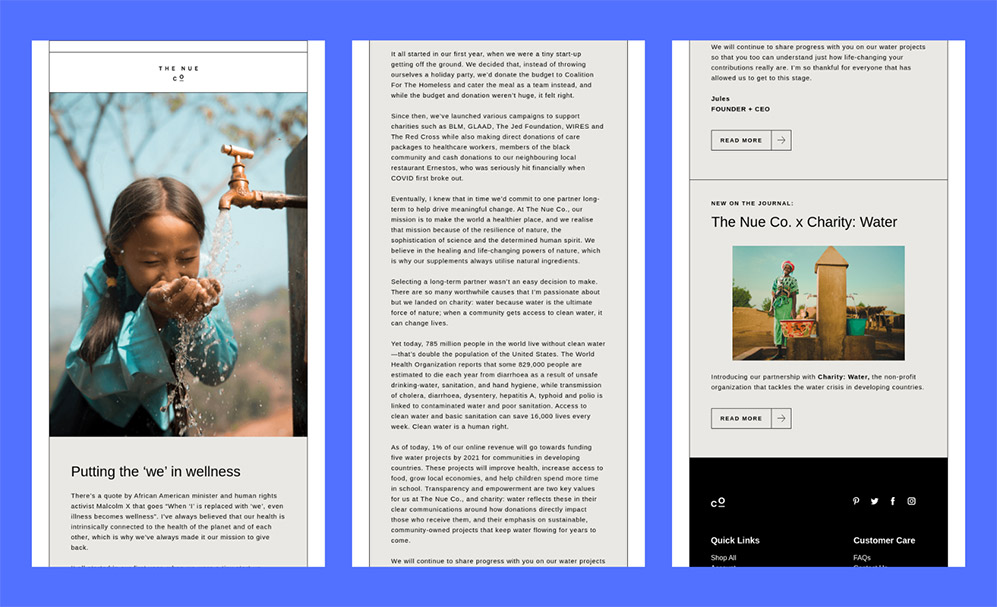
Holiday email marketing pairs well with other promotional channels like social media. Let’s assume you host a special online event or webinar on International Yoga Day. Invite people via email. If you run a social media Halloween contest, use emails to encourage participation.
You can use retargeting on social media. If someone clicks on a product in your Black Friday email but doesn’t purchase it, you can demonstrate an ad with this item on social media. Another benefit of social networks is the ability to work with influencers. If you collaborate with them, mention it in emails, adding more credibility to the brand.
Wrapping Up and Planning Ahead
As we turn the page on the calendar, it’s vital to know how to use holiday email marketing to your advantage. Holidays are more than red-letter days. They provide a chance to really engage the target audience. But remember, each holiday requires a different approach according to its vibe.
We’ve outlined several important strategies to stand out during holidays, such as:
- Personalizing emails by using subscribers’ names and crafting content that speaks to their needs and preferences;
- Planning your schedule;
- Testing email newsletters, from holiday email subject lines to design layouts and refining tactics;
- Leveraging lesser-known holidays;
- Integrating with social media and employing retargeting.
Review past performance. Stay updated on trends. Experiment with new ideas, as there’s always more to explore. And if you need an easy-to-use platform to create messages and manage holiday email marketing campaigns, the Get a Newsletter platform can meet your needs.
Get started with email marketing
Create beautiful email newsletters for free with Get a Newsletter and reach your subscribers and customers in a heartbeat.
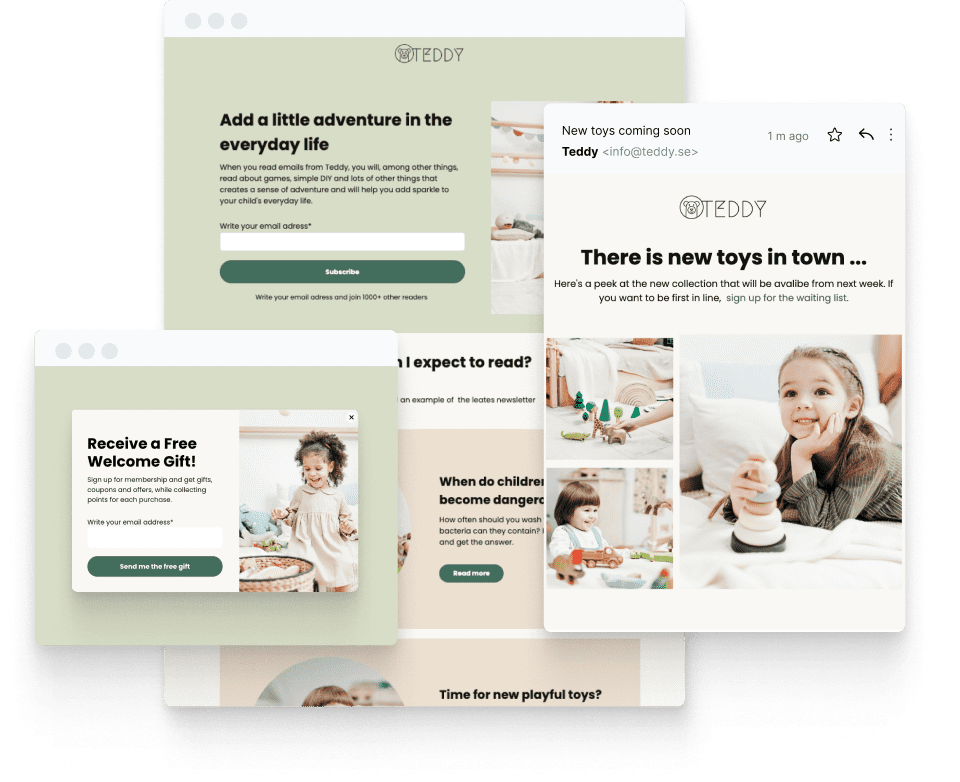

Art Malkovich
Art Malkovich is a co-founding partner and CEO at Onilab. The company develops eCommerce websites and progressive web apps on a turnkey basis, offers store migration and UX/UI design services. Art has a profound expertise in web development, project management, and data analysis. He strives to keep the team one step ahead with a current focus on headless commerce.
Leave a Reply